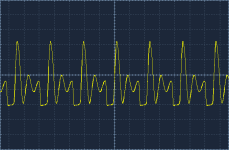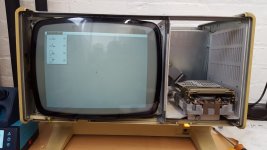Gary C
Veteran Member
So, this thread is looking for help to diagnose a Lisa video fault.
I know it is probably capacitors (!) but I would like if I could, hopefully engaging Hugo's expertise to step through the fault and learn something about how the circuit works and maybe it will help others.
So symptoms.
The machine works and video is present on the rear connector, but the screen has no High voltage present in that there is no static on the tube (it was working a few weeks ago)
Drawing here https://archive.org/details/bitsavers_applelisaho_259795
Knowing the high voltages are created from the horizontal drive, measuring at Q5 collector I get
View attachment 1264197
20.7V peak & 22.7 kHz
To the neck, on red I just get 41V DC ?
I also note that at the flyback (violet) which should be 28V, I am only getting 7V from the regulator U1.
How does that part of the circuit work ? Q5 turns on and off to oscillate the flyback, with the 28V being the supply ? The regulator is hot
I know it is probably capacitors (!) but I would like if I could, hopefully engaging Hugo's expertise to step through the fault and learn something about how the circuit works and maybe it will help others.
So symptoms.
The machine works and video is present on the rear connector, but the screen has no High voltage present in that there is no static on the tube (it was working a few weeks ago)
Drawing here https://archive.org/details/bitsavers_applelisaho_259795
Knowing the high voltages are created from the horizontal drive, measuring at Q5 collector I get
View attachment 1264197
20.7V peak & 22.7 kHz
To the neck, on red I just get 41V DC ?
I also note that at the flyback (violet) which should be 28V, I am only getting 7V from the regulator U1.
How does that part of the circuit work ? Q5 turns on and off to oscillate the flyback, with the 28V being the supply ? The regulator is hot
Last edited:




